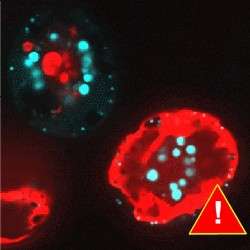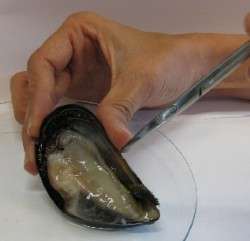Shellfish not safe to eat marked with warning light

Red tides and similar blooms can render some seafood unsafe to eat, though it can be difficult to tell whether a particular batch harbors toxins that cause food poisoning.
A new kind of marker developed by chemists at the University of California, San Diego, and reported in the journal ChemComm makes it easier to see if shellfish are filled with toxin-producing organisms.
Mussels and oysters accumulate single-celled marine creatures called dinoflagellates in their digestive systems as they filter seawater for food. Usually dinoflagellates are harmless, but sometimes they produce dangerous toxins. The trick is figuring out when.

Scientists think symbiotic bacteria that live on the surface of dinoflagellates probably help synthesize the toxins, but no one is sure how. Genetic tools often used to sort out such relationships don’t work for dinoflagellates, which have enormous genomes that are not well understood.
So chemistry professor Michael Burkhart’s group took a different approach. They set up a system to add a fluorescent tag to an enzyme that makes one kind of toxin, okadaic acid, but with a twist. By handing the tag to a the molecule that turns the enzyme on, they ensured that only those parts of cells that are capable of making the toxin would glow.
Specks glow brightly on the surface of dinoflagellates incubated with both the marker and symbiotic bacteria, and the toxin accumulates in the culture. Those lights go off, and toxin production ceases, if the chemists add antibiotics to the mix.
The new marker proved useful in live mussels as well. Their guts glowed with toxin-producing dinoflagellates even before the poison transferred to the mussel tissue itself.
This technique may could be the basis of an early warning system for aquaculturists and in theory it could lower the risk of shellfish poisoning.
Right now, the method requires a relatively expensive fluroscence microscope to view the tagged cells, but Burkhart’s team is optimistic that rapidly developing technology will soon make the tag easy to detect with a handheld device.
Provided by University of California - San Diego




















